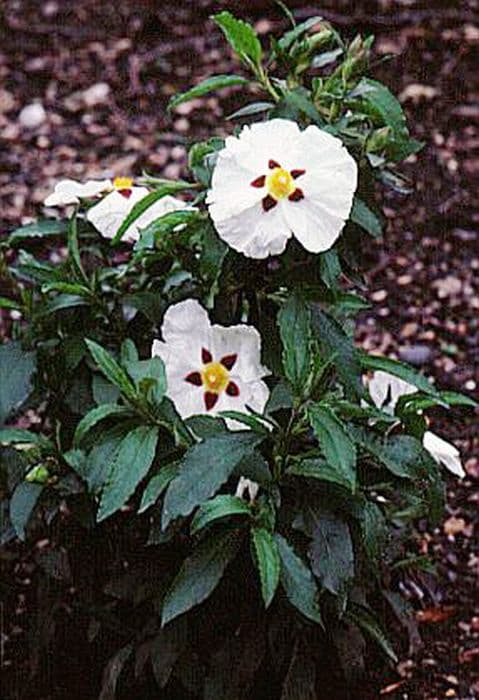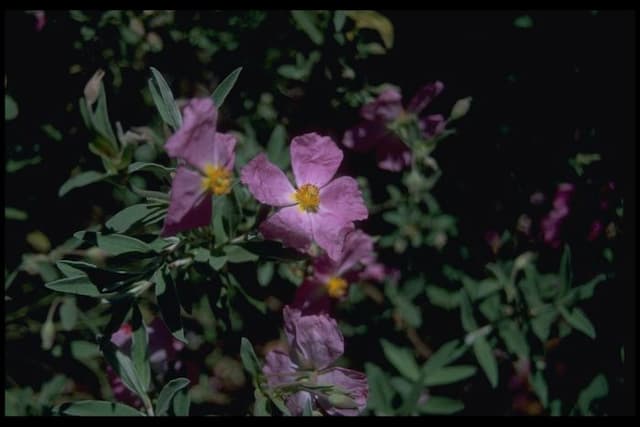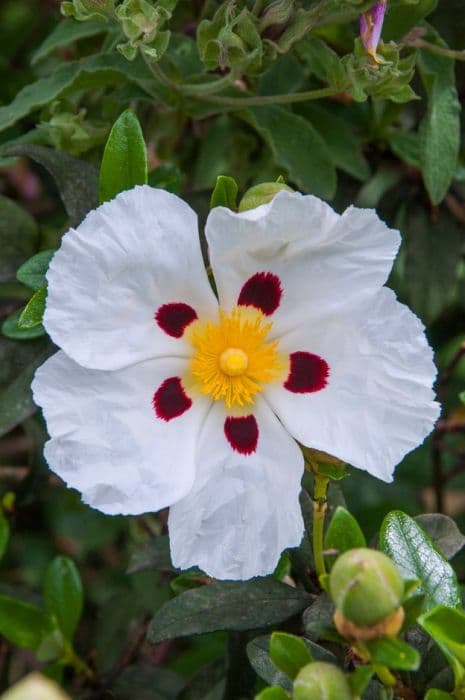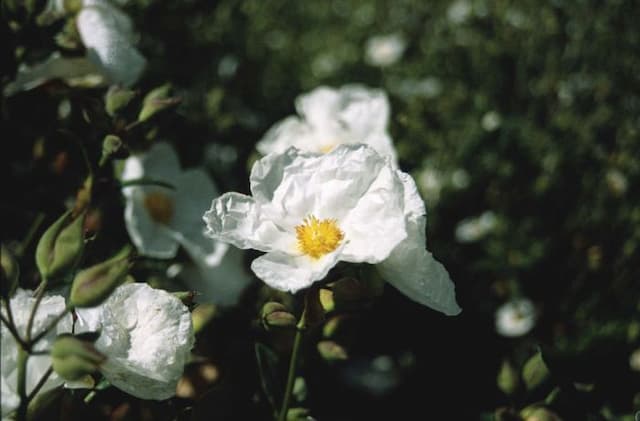Rock Rose Cistus × fernandesiae 'Anne Palmer'

ABOUT
Cistus × fernandesiae 'Anne Palmer', commonly known as Rock Rose 'Anne Palmer', is a visually striking plant with an expressive appearance that resonates well in gardens and natural landscapes. The plant features a lush, bushy form with a dense foliage of slightly wrinkled, green leaves that provide a pleasing backdrop for its standout flowers. The flowers are the main attraction of this Rock Rose variety. They bloom generously, typically boasting a large size with a delicate, papery texture that creates a wonderful contrast against the sturdier leaves. Each bloom presents a soft, pastel pink hue that exudes a gentle charm. At the center, the flowers are adorned with a prominent, yellow cluster of stamens that draw the eye and enhance their ornamental appeal. These vibrant stamens add a pop of bright color and serve as a magnet for pollinators such as bees and butterflies which are often enticed by the blooms. Rock Rose 'Anne Palmer' exhibits a timeless elegance in its flowering display, with the tender pinks blending seamlessly into a variety of garden compositions and themes. The overall aspect of the plant is one of robust health and vitality, ensuring it stands out as a specimen of choice for gardeners looking to incorporate a resilient yet beautiful plant into their outdoor spaces. Its flowers, foliage, and the graceful habit form an exquisite aesthetic that can suit both formal and informal gardens without the need for extensive maintenance or special care.
About this plant
 Names
NamesFamily
Cistaceae
Synonyms
Anne Palmer Rockrose
Common names
Cistus × fernandesiae 'Anne Palmer'.
 Toxicity
ToxicityTo humans
Cistus, commonly known as rockrose, is not known to be toxic to humans. There are no significant reports of poisoning or adverse health effects from ingesting the plant.
To pets
Rockrose, the common name for Cistus, is not recognized as toxic to pets either. As with any non-food plant material, ingestion may cause mild gastrointestinal upset, but there are no specific toxins or poisonings associated with this plant.
 Characteristics
CharacteristicsLife cycle
Perennials
Foliage type
Evergreen
Color of leaves
Green
Flower color
White
Height
3 feet (0.91 meters)
Spread
3 feet (0.91 meters)
Plant type
Shrub
Hardiness zones
8
Native area
Mediterranean
Benefits
 General Benefits
General Benefits- Aesthetic Appeal: Cistus × fernandesiae 'Anne Palmer' offers ornamental value with its large, showy pink flowers that can enhance the visual appeal of gardens and landscapes.
- Drought Tolerance: This plant is well-suited for xeriscaping due to its ability to withstand dry conditions once established, reducing the need for frequent watering.
- Low Maintenance: It generally requires minimal care, making it a convenient option for gardeners with limited time or those new to gardening.
- Attracts Pollinators: The flowers can attract bees and other pollinating insects, supporting biodiversity and helping the pollination of nearby plants.
- Evergreen Foliage: The plant provides year-round greenery, contributing to a continuous display of color even when other plants are dormant.
- Fast Growth: Cistus × fernandesiae 'Anne Palmer' tends to grow quickly, allowing for rapid establishment and filling in garden spaces efficiently.
- Erosion Control: Its root system can help to stabilize soil and prevent erosion on slopes or in areas prone to soil loss.
- Adaptable: It can grow in a variety of soil types, from poor to moderately fertile, provided they are well-drained.
- Sun-Loving: Thrives in full sun, making it suitable for sunny spots where other plants might struggle.
- Deer Resistance: Often resistant to deer, which can be beneficial in areas where deer browsing is a problem for gardeners.
 Medical Properties
Medical PropertiesThis plant is not used for medical purposes.
 Air-purifying Qualities
Air-purifying QualitiesThis plant is not specifically known for air purifying qualities.
 Other Uses
Other Uses- Cistus × fernandesiae 'Anne Palmer', commonly known as Rockrose, can be used as a natural dye for fabrics, offering a range of colors from yellows to browns depending on the mordant used.
- The sticky resin called labdanum harvested from the leaves and stems of the Rockrose is historically used in perfumes, incense, and aromatherapy products for its warm, amber-like fragrance.
- Landscaping with Rockrose can be beneficial for erosion control due to its extensive root system, making it a practical choice for stabilizing slopes and banks.
- Rockrose is sometimes used in companion planting to attract beneficial insects to gardens due to its abundant and nectar-rich flowers.
- The dense, low-growing habit of the Rockrose makes it suitable as a living mulch to suppress weeds and retain soil moisture in garden beds.
- Rockrose petals can be used to make a delicate and aromatic tea, though this is a much less common use and may not be well known.
- In crafting, the dried petals of Rockrose can be incorporated into homemade paper to add texture and visual appeal to the final product.
- Rockrose plants can act as a fire-resistant barrier in fire-prone areas due to their ability to resist flames, which is particularly beneficial in Mediterranean climates.
- The Rockrose can be planted in coastal areas, as it is tolerant of salt spray and can help in building a wind protective screen for more sensitive plants.
- Woodworkers value the sometimes twisted and gnarled branches of older Rockrose plants for creating unique, rustic pieces of furniture and decorative objects.
Interesting Facts
 Feng Shui
Feng ShuiThe Rock Rose is not used in Feng Shui practice.
 Zodiac Sign Compitability
Zodiac Sign CompitabilityThe Rock Rose is not used in astrology practice.
 Plant Symbolism
Plant Symbolism- Resilience: Cistus, also commonly known as rockrose, is a plant that thrives in tough, rocky soil, symbolizing one's ability to persist and flourish in challenging conditions.
- Beauty: With its attractive flowers, the rockrose symbolizes beauty and aesthetic appeal, reminding us of nature's capacity to dazzle the senses.
- Healing: Traditionally, some species of Cistus have been used in herbal remedies, and so the plant has come to symbolize healing and therapeutic qualities.
- Protection: The thick, resinous substance produced by some Cistus plants is thought to protect the plant in its wild habitat, translating into a symbol of protection for humans.
- Purity: The rockrose's bright and delicate flowers are often associated with purity and innocence.
 Water
WaterRockrose 'Anne Palmer' prefers well-draining soil and does not like to be waterlogged, so water thoroughly but infrequently. During the growing season, water when the top inch of soil feels dry, typically every 7 to 10 days, using approximately 1 gallon of water per plant, depending on size and environmental conditions. Reduce watering in the winter months when the plant is not actively growing, possibly to once every two to three weeks. Always ensure the plant has adequate drainage to prevent root rot.
 Light
LightRockrose 'Anne Palmer' thrives in full sunlight, so it's best to place the plant in a location where it can receive at least six hours of direct sunlight daily. It can tolerate partial shade but will produce the best blooms and densest growth in full sun. Avoid heavily shaded areas as this can lead to poor flowering and leggy growth.
 Temperature
TemperatureRockrose 'Anne Palmer' is hardy and can withstand temperatures as low as 15°F once established but prefers the temperature to be above freezing during its growing season. The ideal temperature range for this plant is between 50°F and 75°F. It can tolerate hot temperatures but may need additional watering if temperatures frequently exceed 90°F.
 Pruning
PruningPrune Rockrose 'Anne Palmer' after flowering to maintain its shape and remove any spent blooms. Typically, pruning can be done annually, in the late spring or early summer. Lightly shape the plant by cutting back up to one-third of its size to promote denser foliage and encourage next year's blooms. The best time for pruning is immediately after the blooms have faded.
 Cleaning
CleaningAs needed
 Soil
SoilThe Rock Rose 'Anne Palmer' prefers well-drained soil with a slightly acidic to neutral pH of approximately 5.5 to 7.5. A mixture with equal parts of loam, peat, and sharp sand or perlite would suit this plant well, ensuring good drainage while retaining adequate moisture.
 Repotting
RepottingRock Rose 'Anne Palmer' should be repotted approximately every 2-3 years to refresh the soil and to accommodate root growth. It's best to repot in the spring before new growth begins.
 Humidity & Misting
Humidity & MistingRock Rose 'Anne Palmer' tolerates a wide range of humidity levels but prefers moderate humidity. Keeping this plant in normal room humidity will suffice, as it doesn't require high humidity levels.
 Suitable locations
Suitable locationsIndoor
Ensure bright light, well-draining soil, and occasional watering for indoor growth.
Outdoor
Plant in full sun, sheltered location, well-draining soil, water moderately.
Hardiness zone
8-11 USDA
 Life cycle
Life cycleCistus × fernandesiae 'Anne Palmer', commonly known as Rockrose, begins its life cycle with seed germination, which is often sporadic and may be promoted by fire or physical disturbance of the seed coat. Once germinated, the seedlings grow rapidly and establish a deep root system in preparation for the dry Mediterranean climates they thrive in. The plant enters a vegetative state during which it produces woody stems and evergreen leaves, and after 2-3 years, it reaches maturity and begins to flower, usually in late spring to early summer. The Rockrose's flowers are showy and last for only a day, after which they are quickly replaced by fresh blooms over the several-week flowering period. Following pollination, often by bees, the plant produces small capsules containing numerous seeds, which are then dispersed by wind or gravity. The plant can live for several years, and under optimal conditions, it may live for a decade or more before naturally declining.
 Propogation
PropogationPropogation time
Spring-Early Summer
Propogation: Cistus × fernandesiae 'Anne Palmer', commonly known as Rockrose, is most commonly propagated through semi-hardwood cuttings. This method involves taking cuttings from the current season's growth, which have begun to mature but are not yet fully hardened. The ideal time to take these cuttings is in late summer. Cuttings should be about 4 to 6 inches long, with the lower leaves removed. The cut end is typically dipped in rooting hormone powder to encourage root growth, and then the cutting is placed in a well-draining potting mix. Maintaining high humidity and consistent moisture levels without waterlogging is crucial for successful rooting. Propagation through cuttings can take several weeks, and once rooted, the new plants can be gradually hardened off before transplanting to their final location.









